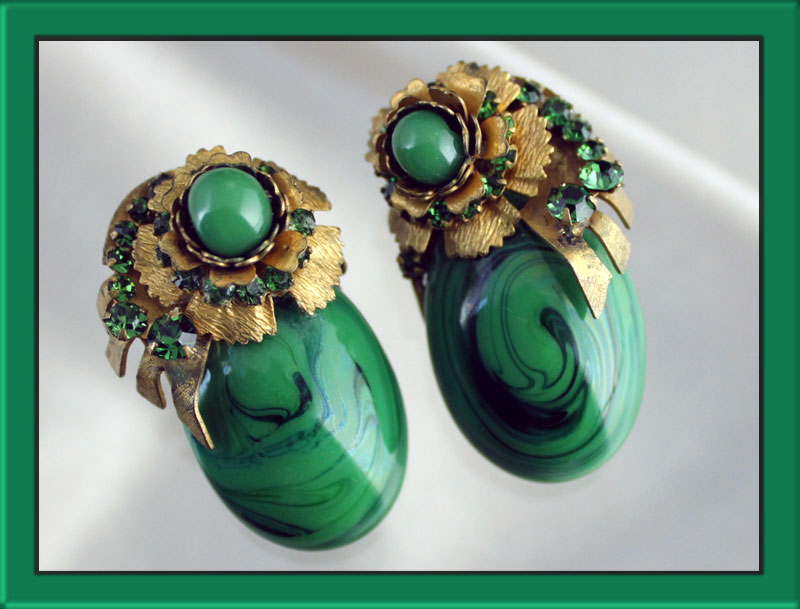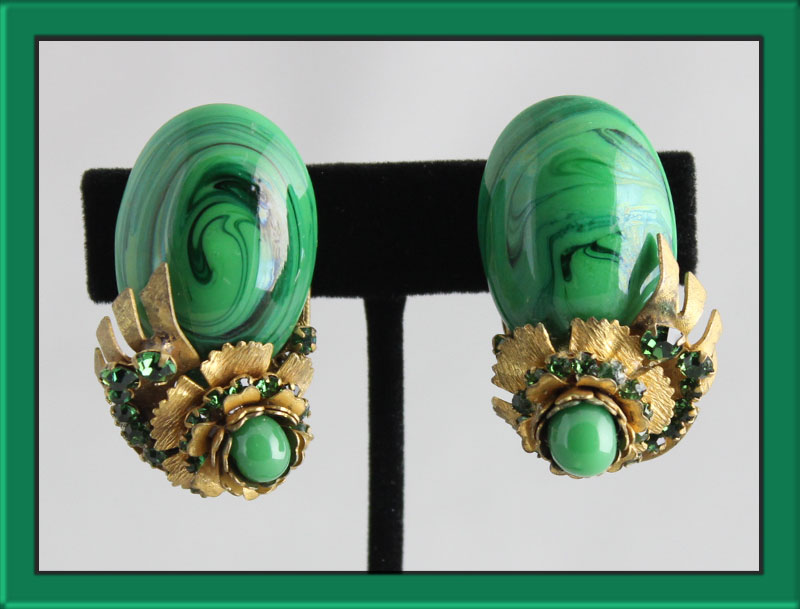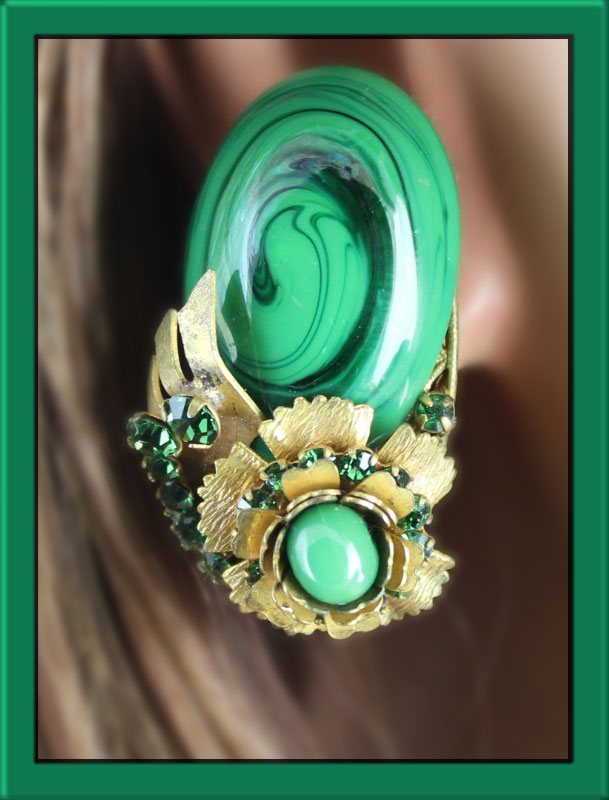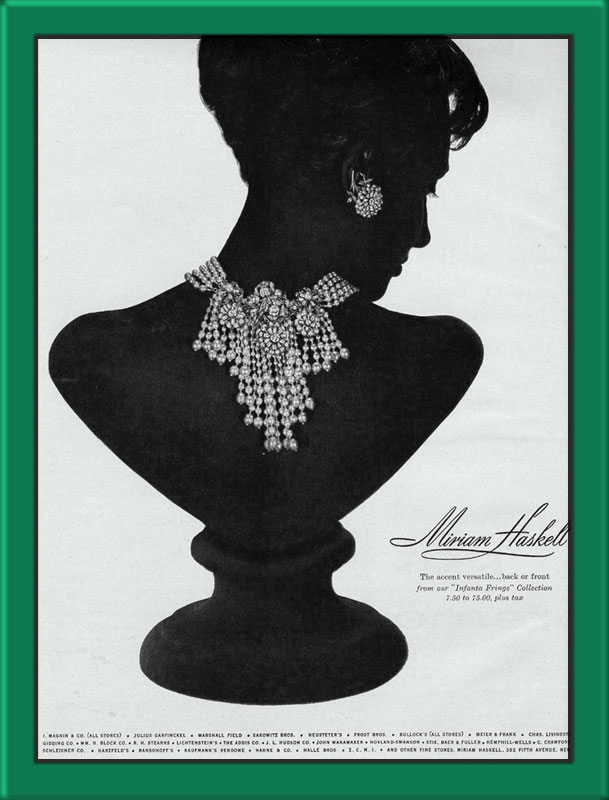Return To Previous Page
Miriam Haskell | Large Green Art Glass Earrings
Miriam Haskell | Large Green Art Glass Earrings
. . . . So Chic!
Miriam Haskell
There is no mistaking Miriam Haskell. Beautiful oval shaped green and black glass have been given center stage as the centerpiece to these lovely earrings. The emerald green of the chatons is so rich. I haven't been able to find another pair like them, nor can I find any of the complimentary pieces to a set. Really a great find for any Haskell collector. ID-493
There is no mistaking Miriam Haskell. Beautiful oval shaped green and black glass have been given center stage as the centerpiece to these lovely earrings. The emerald green of the chatons is so rich. I haven't been able to find another pair like them, nor can I find any of the complimentary pieces to a set. Really a great find for any Haskell collector. ID-493
Measurements:
Earrings — Approximately 1 ⅝ tall by 1" wide.
Miriam Haskell Jewelry History —
Haskell was born on July 1, 1899, in Tell City, Indiana, a small town across the Ohio River from Louisville, Kentucky. After high school in nearby New Albany, where her Russian Jewish immigrant parents ran a dry-goods store, she studied for three years at Chicago University. Moving to New York City in 1924 with $500 in her pocket, she opened a jewelry boutique in 1926 in the old McAlpin Hotel, and a second outlet within the year at West 57th Street. Frank Hess joined her business the same year. Despite some controversy concerning the extent to which the jewelry designs are Haskell's or Hess's (Ellman quotes Haskell's nephew's claim that she designed a great deal; Pamfiloff and others give the lion's share of credit to Hess), the two worked together until Miriam left the company; Hess continued to design for many years afterwards. In the 1930s, the company relocated to 392 Fifth Avenue; their affordable art glass, strass, and gold-plate parures were popular throughout the Great Depression, and the company went on to open boutiques at Saks Fifth Avenue and Burdine's, as well as stores in Miami and London. The Saks shop also offered pieces by Chanel.
Miriam Haskell jewelry was worn for publicity shots, films, and personal use by movies stars Joan Crawford and Lucille Ball, as well as by Gloria Vanderbilt and the Duchess of Windsor. Crawford owned a set of almost every Haskell ever produced, from the 1920s through the 1960s.
Watercolors used for advertising, by Larry Austin and others, showing models wearing large Haskell pieces are also collected and a Florida dealer found many in a set of steamer trunks around 1978; Haskell's family sold her archives and samples to defray the costs of her nursing home.
Her vintage pieces can command high prices from collectors. However, her jewellery was seldom signed before 1950, it was her brother Joseph Haskell who introduced the first regularly signed Miriam Haskell jewellery. For a very short time during the 1940s, a shop in New England did request all pieces they received be signed by Miriam - this signature being a horseshoe-shaped plaque with Miriam Haskell embossed on it. Pieces with this signature are rare.
Haskell's clients included Florenz Ziegfeld, who decorated the chorines of his Follies with her designs; Bernard Gimbel of the department store chain; and John D. Hertz, Jr., scion of the car-rental company. With Hess, she traveled in search of materials to Paris, Gablonz, Venice, and Wattens, home of Daniel Swarovski's crystal factory. She built a mansion that she called Sainte Claire Cottage on the Hudson River near Ossining. When the Ohio flooded in 1937, Haskell sent boxcars full of relief materials to New Albany, and traveled home to assist during the disaster. In World War Two, she contributed most conscientiously to the war effort, and asked Hess to create new patriotic metalfree jewelry designs, using natural materials and plastics.
The horror of World War II affected her health and emotional stability; in her fifties, she became ill, despite an adherence to health food. In 1950, she lost control of her company to her brothers. Living in an apartment on Central Park South with her widowed mother through the next decades, she became increasingly erratic in her behavior. In 1977, she moved to Cincinnati, under the care of her nephew Malcolm Dubin, and died in 1981. It was a sad ending for an exceptional life, but, as Pamfiloff writes, "Obviously, the legacy of her dream has filtered on down through the decades. It was a man's world. Designers were men. The owners of companies were men. The staff was men. The salesmen were men. It was all men. And then you had Coco Chanel, who just jumped right out there, and a couple of other women who carved out their own niche in the world. Haskell did that, too."
Wikipedia: Miriam Haskell: [https://en.wikipedia.org/wiki/Miriam_Haskell]: [Sept 15, 2016]
Having trouble with the small sizes of
yesteryear? Well, most of us do!
The ladies were smaller than the women of today.
NO Problem, be sure to check out our necklace extenders.
The ladies were smaller than the women of today.
NO Problem, be sure to check out our necklace extenders.



